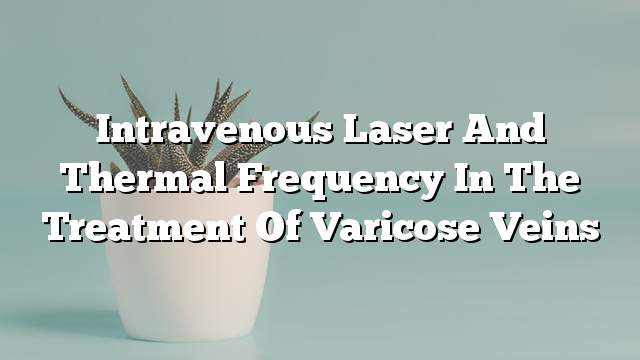Varicose veins are a non-aesthetic phenomenon of humans and they reflect the failure of the superficial and deep venous system, which results in an increase in venous tension. The varicose veins were discovered in the fifth century BC, and Greek scientists like Abu Qarat described the symptoms of the disease and its treatment methods, which Maralat used to this day.
There are several ways to treat varicose veins and the type of treatment is determined after consultation with the treating physician and depends on the treatment of varicose veins and the extent of progress as well as by the type of skin patient and summarized conservative treatment and surgery and thermal treatment and needle and needle surgeries surface laser
The most important treatment methods currently are thermal treatment, which contains three types:
Endovenous laser, radio frequency and steam.
All methods may be performed at the doctor’s clinic under local anesthesia instead of the general anesthesia used in the surgery. The patient can return to work on the same day with no need to sleep in the hospital. The treated patient will feel very little pain and the recurrence of varicose veins is less than that in surgery.
The percentage of closure of the saphen vein by thermal treatment such as laser or thermal frequency for the first year ranges from 95-100% and that the closure is lasting by 94-97% in the fifth year after treatment and this means that the disappearance of the full capsule of varicose veins forever.
What is the best way to treat varicose veins?
The use of both methods is very similar, but the results of some studies showed that the thermal frequency is better than the laser as the patient recovers more and that the incidence of complications in the case of using the thermal frequency is less than the laser, but the competition between the two methods is still very much between the technology manufacturers and its users of doctors.
Why is laser used sometimes instead of thermal frequency?
The duration of treatment by internal laser or thermal frequency is less than an hour and start treatment by identifying the vein sapon by sonar and injection of local anesthesia along the vein sapon under the supervision of the sonar also and then enter the catheter therapeutic tube and then warm the blood inside the vein or venous wall The patient is then monitored by the sonar to determine the percentage of the venous vein closure. The use of thermal frequency can treat the saphenic vein expanding up to 16 mm.
Unfortunately, these therapeutic methods can not treat the venous web, and most patients need follow-up for the remaining hardening of the veins. These veins can be removed if necessary through small wounds during local anesthesia. The closure of the vein saphen by thermal treatment does not mean the possibility of recurrence of superficial varicose II, which may result from the reopening of the vein or the appearance of venous reflux, and therefore the patient should follow his case from time to time with the specialist doctor.
In conclusion, internal laser therapy and thermal thermotherapy are modern treatments for varicose veins and the proportion of patients treated in this method is 80%, while surgery is only 20%. We can say that there is a significant scientific progress in the treatment of varicose veins, whether using laser or thermal frequency Or steam, which if used correctly and by experienced people resulting in permanent cure for the disease and the exclusion of unwanted side effects.
